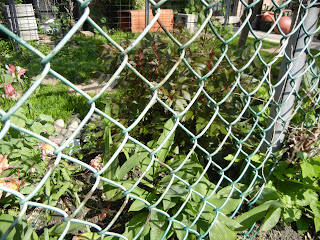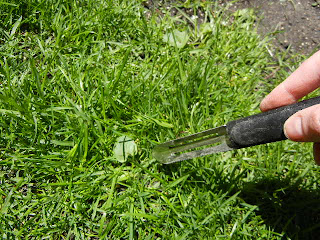Climbing plants aside, do some plants look better than others next to a chain-link fence? This isn't a great shot, but it's actually true to life.That's an astilbe there, in case you didn't see it. Not the lovely green columbine with pink flowers to the right, the irises and lilies-of-the valley in the back, nor the flopping tulip leaves to the left...but the shadowy thing in the middle.
I love astilbe. It likes part shade and comes back strong every year. It shoots up amazing red brushy plumes about twice each summer. The leaves are small, sharp and elegant, and it's easy to care for.
But sometimes I forget it's there. Some plants have to play a supporting role, fine. But it seems to me that those airy, thin, dark green leaves (with a dark reddish tinge) fail to pack a punch beside a chain-link fence.
But look how these fat magnolia leaves offer such a great, soft, lush contrast to the fence, even hiding it. They give genuine substance to the garden, something a chain-link fence lacks, since it's practically all air (though that's a benefit, as I'll discuss in another post).

It's not just the height of the plant, I think. Take this humble chrysanthemum with its silvery green foliage. It's hardly bright, or translucent, and the leaves have a fine, feathered shape. Yet it stands out pretty well even from outside, perhaps because of its density.
Here is my azalea about a month ago. It's leaves are slightly bigger now, but not much. Against the see-through metal grid of the fence, the effect is frustratingly scattered. The leaves it has now, though slightly bigger, are a dark forest green, so the color just doesn't "pop".
Of course, azaleas also do this...which is why I keep it around.
Am I completely mistaken? Is it just my garden? Or is it possible to lay out guidelines for plants beside a chain-link fence? --Other than hiding it, I mean. Then again, I've also been reconsidering the supposed ugliness of chain-link fences. Perhaps I'm looking at it all wrong...



































